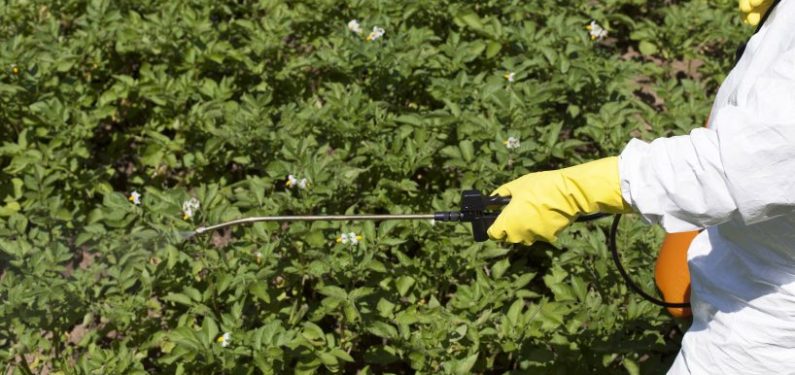
Responsible Pest Management in the Food Chain
March 10, 2022Consumers are continuing to be more aware of the source and the method that supplies our food chain. Social media allows information to be spread rapidly with little regard to the accuracy of the content. That means, as food producers, we must be proactive in consistently using “best practices” and then using every opportunity to engage our neighbors in a positive conversation explaining our farm operation. With the suburbs and production agricultural acreage becoming closer neighbors geographically, educational and neighborly interaction is increasingly critical for everyone. Here’s what to know and communicate about responsible pest management in the food chain:
Mechanical Controls vs Modern Tools for Managing Insects, Weeds, and Fungi
Essentially, there are three main areas of pest management in agricultural production – insects, weeds, and fungi. With that, we have a need for insecticides, herbicides, and fungicides.
A short brief history of the use of these methods will show that in the past, 30 plus years ago, these tools were replacing the more mechanical controls such as complete annual tillage and cultivation.
These methods were the “best practices” at the time, but they came with their own set of disadvantages such as erosion and runoff. With the rapidly growing worldwide population needing to be fed, food production, meaning yields, must continue to increase to meet demand.
Responsible Pest Management in the Food Chain Increases Yields
Did you know that the national average corn production passed the 100 bushels per acre mark in the mid-70s? Today, we are approaching 200 bushels and projections indicate we could be close to 300 bushels by 2030.
Consider a bit of background, what has contributed to the dramatic increase in yields? It is directly related to the increased knowledge relating to hybrids in plants and to the chemistry in the products available to manage pests.
Genetic Plant Resistance to Specific Pests
In the plant world, we now can manage the genetics of the plant to be able to use naturally occurring resistance to certain insect larvae. For example, bt corn refers to corn with the naturally occurring soil microbe, Bacillus Thuringiensis, added to the corn seed. This then produces a plant material that is toxic to a specifically targeted insect pest.
The advantages of this type of production management would be that it increases production, and saves time and expense producing the crop. It also allows for the use of better conservation methods such as no-till, which then results in less erosion and waterway contamination. Bt genetics kills and manages the pest at the plant level rather than through insecticide application.
Insecticides and Rodenticides to Protect Livestock
On the animal production side, the use of insecticides and rodenticides protects the livestock from stress, swatting files and biting bugs, and disease-carrying mice and rats. This improves animal comfort, which also reduces stress and increases the efficiency of the livestock.
Communication About Responsible Pest Management Practices to Neighbors
With those brief examples for the value of pest management, let’s consider why and how our neighbors perceive what is happening on the farm.
What Neighbors May Get From Other Sources
Our friends that may live right beside the cornfield receive and evaluate their information from an entirely different source and perspective. It may come from the news media, or social media such as Facebook, Instagram, Twitter, TikTok, Snapchat, and others.
Many times, the information is not necessarily based on science. Their evaluation of the risk may be based on subjective perceptions, intuitive judgments, or inferences made from media coverage. They may assume they are exposed if they simply see you applying material to your field.
Or, it may also be based on whether they perceive that they are far enough away from the field, or how it is applied – ground application vs. aerial. As farmers/producers, you must go by the actual science and the news media does not always share the scientific data.
How Farmers/Producers Can Proactively Communicate With Neighbors
As the farmer/producer, it is imperative to communicate proactively with your neighbors. Talk with them before the season starts and establish a positive relationship. Show them respect and do not diminish their concerns.
Relay the benefits of what you do as it relates to them personally. Make them aware of resources that are published and available to them relating to hypersensitivity. There is a list published by the FDA. You as a farmer have access to product research information that is not readily available to the general public.
Your neighbors and friends enjoy the availability, quality, quantity, and variety of food that they have when they go to the supermarket or the local farmers’ market. Helping them understand and appreciate your world is vital for the future interaction between the two of you. This will go far when they see you later in the year planting, spraying, and harvesting your crop.
Additional information and resources are available through your respective Agricultural Extension office. You can also contact our agency and we can be helpful in finding educational material to share with your neighbors and friends. We can be reached at 800-537-6880 or 717-665-2283.
Thanks for your dedication and hard work in feeding all of us. We do not express that enough!
Disclaimer: Information and claims presented in this content are meant for informative, illustrative purposes and should not be considered legally binding.

